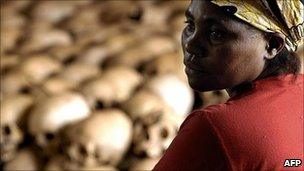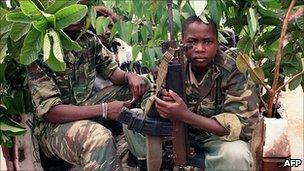Rwanda: How the genocide happened
- Published

Some 800,000 people were killed in Rwanda's genocide in just 100 days
Between April and June 1994, an estimated 800,000 Rwandans were killed in the space of 100 days.
Most of the dead were Tutsis - and most of those who perpetrated the violence were Hutus.
Even for a country with such a turbulent history as Rwanda, the scale and speed of the slaughter left its people reeling.
The genocide was sparked by the death of the Rwandan President Juvenal Habyarimana, a Hutu, when his plane was shot down above Kigali airport on 6 April 1994.
A French judge has blamed current Rwandan President, Paul Kagame - at the time the leader of a Tutsi rebel group - and some of his close associates for carrying out the rocket attack.
Mr Kagame vehemently denies this and says it was the work of Hutu extremists, in order to provide a pretext to carry out their well-laid plans to exterminate the Tutsi community.
Whoever was responsible, within hours a campaign of violence spread from the capital throughout the country, and did not subside until three months later.
But the death of the president was by no means the only cause of Africa's largest genocide in modern times.
History of violence
Ethnic tension in Rwanda is nothing new. There have always been disagreements between the majority Hutus and minority Tutsis, but the animosity between them has grown substantially since the colonial period.
The two ethnic groups are actually very similar - they speak the same language, inhabit the same areas and follow the same traditions.
However, Tutsis are often taller and thinner than Hutus, with some saying their origins lie in Ethiopia.
During the genocide, the bodies of Tutsis were thrown into rivers, with their killers saying they were being sent back to Ethiopia.
When the Belgian colonists arrived in 1916, they produced identity cards classifying people according to their ethnicity.
The Belgians considered the Tutsis to be superior to the Hutus. Not surprisingly, the Tutsis welcomed this idea, and for the next 20 years they enjoyed better jobs and educational opportunities than their neighbours.
Resentment among the Hutus gradually built up, culminating in a series of riots in 1959. More than 20,000 Tutsis were killed, and many more fled to the neighbouring countries of Burundi, Tanzania and Uganda.
When Belgium relinquished power and granted Rwanda independence in 1962, the Hutus took their place. Over subsequent decades, the Tutsis were portrayed as the scapegoats for every crisis.
Building up to genocide
This was still the case in the years before the genocide. The economic situation worsened and the incumbent president, Juvenal Habyarimana, began losing popularity.
At the same time, Tutsi refugees in Uganda - supported by some moderate Hutus - were forming the Rwandan Patriotic Front (RPF), led by Mr Kagame. Their aim was to overthrow Habyarimana and secure their right to return to their homeland.
Habyarimana chose to exploit this threat as a way to bring dissident Hutus back to his side, and Tutsis inside Rwanda were accused of being RPF collaborators.
In August 1993, after several attacks and months of negotiation, a peace accord was signed between Habyarimana and the RPF, but it did little to stop the continued unrest.
When Habyarimana's plane was shot down at the beginning of April 1994, it was the final nail in the coffin.
Exactly who killed the president - and with him the president of Burundi and many chief members of staff - has not been established.
Whoever was behind the killing its effect was both instantaneous and catastrophic.
Mass murder
In Kigali, the presidential guard immediately initiated a campaign of retribution. Leaders of the political opposition were murdered, and almost immediately, the slaughter of Tutsis and moderate Hutus began.
Within hours, recruits were dispatched all over the country to carry out a wave of slaughter.

Boys were among those recruited into militia groups
The early organisers included military officials, politicians and businessmen, but soon many others joined in the mayhem.
Organised gangs of government soldiers and militias hacked their way through the Tutsi population with machetes, or blew them up in churches where they had taken refuge.
The extremist ethnic Hutu regime in office in 1994 appeared genuinely to believe that the only way it could hang on to power was by wiping out the ethnic Tutsis completely.
Encouraged by the presidential guard and radio propaganda, an unofficial militia group called the Interahamwe (meaning those who attack together) was mobilised. At its peak, this group was 30,000-strong.
Soldiers and police officers encouraged ordinary citizens to take part. In some cases, Hutu civilians were forced to murder their Tutsi neighbours by military personnel.
Participants were often given incentives, such as money or food, and some were even told they could appropriate the land of the Tutsis they killed.
On the ground at least, the Rwandans were largely left alone by the international community. Most of the UN troops withdrew after the murder of 10 soldiers.
The day after Habyarimana's death, the RPF renewed their assault on government forces, and numerous attempts by the UN to negotiate a ceasefire came to nothing.
Aftermath
Finally, in July, the RPF captured Kigali. The government collapsed and the RPF declared a ceasefire.
As soon as it became apparent that the RPF was victorious, an estimated two million Hutus fled to Zaire (now the Democratic Republic of Congo).
These refugees include many who have since been implicated in the massacres.
At first, a multi-ethnic government was set up, with a Hutu, Pasteur Bizimungu as president and Mr Kagame as his deputy.
But the pair later fell out and Bizimungu was jailed on charges of inciting ethnic violence, while Mr Kagame became president.
Although the killing in Rwanda was over, the presence of Hutu militias in DR Congo has led to years of conflict there, causing up to five million deaths.
Rwanda's now Tutsi-led government has twice invaded its much larger neighbour, saying it wants to wipe out the Hutu forces.
And a Congolese Tutsi rebel group remains active, refusing to lay down arms, saying otherwise its community would be at risk of genocide.
The world's largest peacekeeping force has been unable to end the fighting.